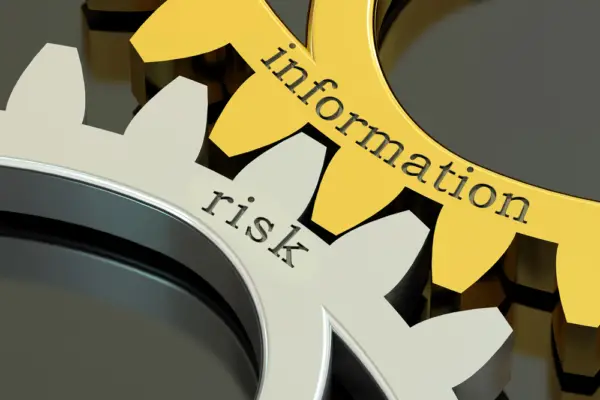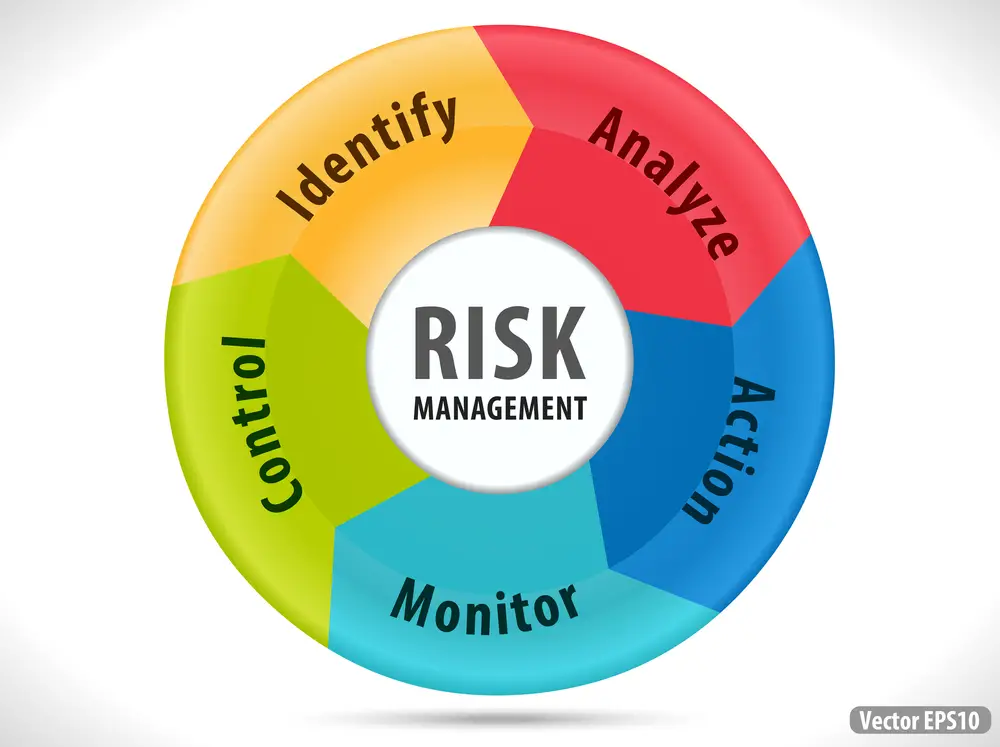Risk response is a process in risk management that involves identifying, assessing, and controlling risks. It is a key part of the overall risk management process, which aims to minimize the potential negative impacts of risks on a project.
There are four main types of risk responses:
Avoidance: This involves changing the project plan to eliminate the risk or to protect the project objectives from its impact. For example, if a project relies on a single supplier for a key resource, the project team might choose to use multiple suppliers to avoid the risk of the single supplier failing to deliver.
Mitigation: This involves reducing a risk’s probability and/or impact. For example, if there’s a risk that a project will go over budget, the project team might implement cost controls or seek additional funding.
Transfer: This involves shifting the impact of a risk to a third party. This is often done through insurance or by outsourcing a risky part of the project to another party.
Acceptance: This involves acknowledging the risk but deciding not to take any action unless the risk occurs. This is often done when the cost of mitigating the risk is higher than the potential impact of the risk.
The chosen risk response should be documented in the project’s risk register, along with the identified risks and their potential impacts. The risk response process should be ongoing, with the project team continually monitoring and reassessing risks as the project progresses.
Risk is an inherent part of any business or project, and it can manifest in various forms, such as financial risk, operational risk, legal risk, reputational risk, and more. While some risks are inevitable, they can be managed effectively through risk response.
Risk response refers to the actions organizations or individuals take to mitigate the impact of potential risks on their objectives. The importance of effective risk response cannot be overstated, as it enables businesses to identify and prioritize potential risks before they occur.
This proactive approach allows them to minimize potential losses and avoid negative consequences from unforeseen events.
This article will explore risk response, its process, the strategies for responding to risks, and how technology significantly mitigates potential threats.

Understanding the Importance of Risk Response
The significance of risk response lies in its ability to provide a structured approach to addressing risks that may impact the achievement of organizational objectives. By identifying potential risks, organizations can take proactive measures to manage them effectively before they escalate into crises.
Risk response is essential to risk management as it involves developing strategies to minimize losses and maximize opportunities.
Risk response is critical for ensuring business continuity and resilience. It enables organizations to anticipate potential threats and develop contingency plans that mitigate their impact on operations.
Effective risk response also involves monitoring the effectiveness of existing controls and implementing new ones when necessary. Through continuous improvement, organizations can strengthen their risk management framework and ensure they are better prepared to deal with emerging risks.
In today’s fast-paced business environment, effective risk response has become increasingly important due to the growing complexity of risks organizations face. The COVID-19 pandemic has highlighted the need for robust risk management frameworks to help businesses respond quickly and efficiently to unforeseen events.
Therefore, risk response enables organizations to navigate uncertain times while maintaining their competitive advantage.
The Risk Response Process
One critical aspect of managing potential hazards or uncertainties is the process involved in determining appropriate actions to take. This process is commonly referred to as risk response, and it consists of the steps taken by individuals or organizations to mitigate, avoid, transfer, or accept risks.
The risk response process should be carried out systematically and strategically to minimize negative impacts on an organization’s objectives.
Four main strategies can be adopted as part of the risk response process to manage risks effectively. These include avoiding the risk altogether by taking proactive measures such as changing processes or procedures; reducing the likelihood of occurrence through mitigation plans; transferring the risk to another party such as an insurance company; or accepting the risk if it falls within a tolerable level.
The first step in a successful risk response process is identifying all possible risks that could impact an organization’s operations. Once identified, these risks should be assessed based on their probability and potential impact before selecting a suitable response strategy.
It is also important to have contingency plans for unforeseen events that may arise during the implementation of the selected strategy.
Effective management of potential hazards requires careful planning and execution of appropriate responses through a systematic approach like the one outlined above.
Types of Risk Response Strategies
Implementing suitable strategies to manage potential hazards and uncertainties involves adopting one of four main approaches, each with its own benefits and drawbacks.
The first approach is risk avoidance, which involves taking proactive measures to avoid the risk altogether. This could mean not pursuing a business venture or investing in a certain market. While this strategy can effectively eliminate risks, it may also limit opportunities for growth and development.
The second approach is risk reduction through mitigation plans. Mitigation plans aim to decrease the likelihood of risks occurring or minimize their impact if they do happen.
Such plans include implementing safety protocols or backup systems that reduce the probability of negative outcomes from materializing. However, these plans can still result in residual risks requiring additional response measures.
The third strategy is risk transfer, which entails shifting the burden of potential losses to a third party, such as an insurance company or contractor. This strategy can relieve financial loss but does not eliminate the underlying risk and can add additional costs for transferring it.
Finally, organizations may accept certain levels of risk as tolerable and focus on managing them effectively instead of trying to eliminate them. This approach involves developing contingency plans that prepare for potential negative consequences while allowing businesses to continue their everyday operations.
| Type of Risk Response | Benefits | Drawbacks |
|---|---|---|
| Risk Avoidance | Eliminates risks entirely | Limits growth opportunities |
| Risk Reduction through Mitigation Plans | Shifts the burden of losses to third party | May still result in residual risks |
| Risk Transfer | Shifts the burden of losses to the third party | Adds additional costs for transferring |
An appropriate strategy depends on factors such as organizational culture, resources available, and stakeholders’ appetite for risk-taking behavior.
Organizations must evaluate potential risks thoroughly before choosing an appropriate response strategy that aligns with their goals and objectives while ensuring adequate protection from potential hazards and uncertainties.
Implementing Effective Risk Response Strategies
To effectively manage potential hazards and uncertainties, organizations must carefully evaluate their available options for addressing them. Implementing effective risk response strategies involves identifying and analyzing risks and assessing the likelihood of their occurrence.
Determining the level of impact, they could have on business operations. Once these factors have been evaluated, organizations can develop and implement appropriate risk response strategies to mitigate or transfer risks.
An important step in implementing effective risk response strategies is prioritizing risks based on their level of impact and likelihood of occurrence. This allows organizations to allocate resources more efficiently toward managing high-priority risks while ensuring that lower-priority risks are not neglected.
Additionally, organizations should consider developing contingency plans that outline specific actions that will be taken if a particular risk eventuates.
Finally, monitoring and reviewing implemented risk response strategies ensures their effectiveness over time. Organizations should establish clear metrics for measuring the success of each strategy and evaluate their performance at predetermined intervals.
Adjustments may need to be made as new information becomes available or business conditions change so the organization remains prepared to deal effectively with potential threats.
The Role of Technology in Risk Response
Integrating advanced technological solutions has become increasingly important in enhancing an organization’s ability to anticipate, identify, and address potential threats.
Adopting technology in risk response strategies allows organizations to monitor and analyze data in real-time, providing timely alerts on potential risks. For instance, predictive analytics enables organizations to identify patterns and trends that could lead to potential risks. This helps them make informed decisions proactively and mitigate any adverse effects that may arise.
Moreover, technology enhances the automation of risk management processes. Automated systems improve efficiency by reducing human error while enabling faster risk responses.
Risk management software can automate monitoring compliance regulations or tracking key performance indicators (KPIs). This provides a comprehensive view of an organization’s risks, allowing decision-makers to prioritize resources effectively.
In addition to improving efficiency, adopting technology also improves collaboration within an organization. Technology enables teams from different departments to work together seamlessly toward managing risks effectively.
Therefore, integrating technology into risk response strategies is essential for modern-day organizations looking to stay ahead in a highly competitive business environment.
| Advantages | Disadvantages |
|---|---|
| Improved Efficiency | Costly Implementation |
| Increased Collaboration | Cybersecurity Threats |
| Real-Time Monitoring | Technical Issues |
| Enhanced Automation | Potential Job Losses |
| Data Analytics Capabilities | Need for Training/Resources |
Integrating technological solutions into risk response strategies brings numerous advantages that cannot be ignored by modern-day organizations seeking success in their operations.
However, there are also challenges involved with implementing these technologies that must be considered carefully before making any significant investments in them. Organizations need experienced professionals to manage these technologies effectively while ensuring they do not pose any cybersecurity threats or technical issues that could harm their operations.
Therefore, organizations must balance technological advancements and traditional risk management methods while ensuring they remain competitive and compliant with regulations in their respective industries.

Frequently Asked Questions
How does risk response differ from risk management?
Risk response refers to the actions taken in response to identified risks. It is a component of risk management, which involves identifying, assessing, and prioritizing risks and developing strategies to mitigate or avoid them.
Can risk response strategies be applied to personal and business situations?
Risk response strategies can be applied to both personal and business situations. These strategies involve identifying, assessing, and responding to risks through various options such as avoidance, mitigation, transfer, or acceptance.
What are some potential negative consequences of not implementing effective risk response strategies?
Failure to implement effective risk response strategies can result in various negative consequences such as financial losses, damage to reputation, legal issues, and even physical harm or loss of life.
It is crucial to prioritize risk management in both personal and business situations.
How do cultural differences impact the effectiveness of risk response strategies in international business?
Cultural differences can impact the effectiveness of risk response strategies in international business by affecting communication, decision-making processes, and perceptions of risk.
It is important to consider cultural factors when developing and implementing these strategies.
Are there any ethical considerations to consider when implementing risk response strategies?
Ethical considerations must be kept in mind when implementing risk response strategies. These include ensuring fairness, transparency, and respect for stakeholders’ rights. Failure to do so can result in reputational damage and legal consequences.

Conclusion
Risk response is an essential aspect of risk management that helps organizations prepare for and mitigate potential risks. Understanding the importance of risk response is critical as it allows companies to identify possible threats and develop effective strategies to manage them.
The risk response involves identifying, assessing, prioritizing, and responding to risks through various strategies such as avoidance, mitigation, transfer, or acceptance.
Implementing effective risk response strategies requires collaboration between different organizational departments and technology to enhance risk assessment processes.
The role of technology in risk response cannot be overstated, as it enables companies to collect data, analyze trends, and monitor potential risks proactively.

Chris Ekai is a Risk Management expert with over 10 years of experience in the field. He has a Master’s(MSc) degree in Risk Management from University of Portsmouth and is a CPA and Finance professional. He currently works as a Content Manager at Risk Publishing, writing about Enterprise Risk Management, Business Continuity Management and Project Management.

